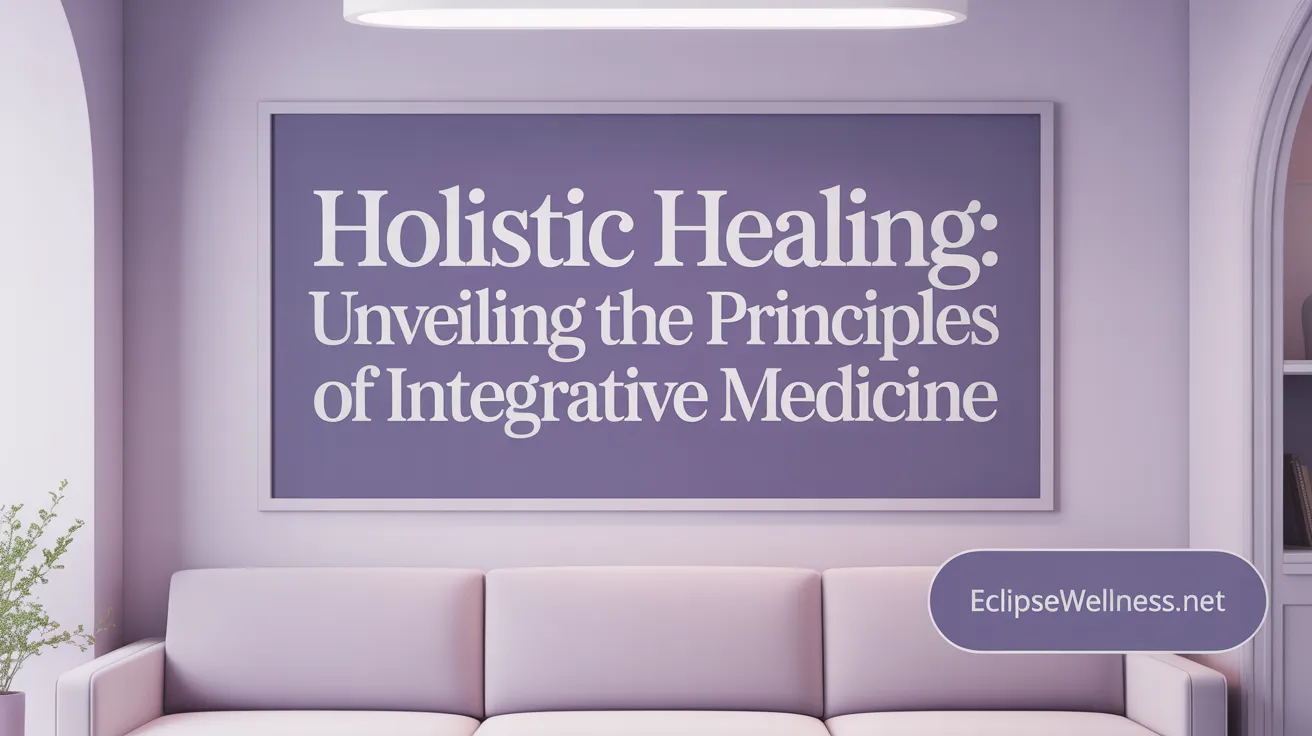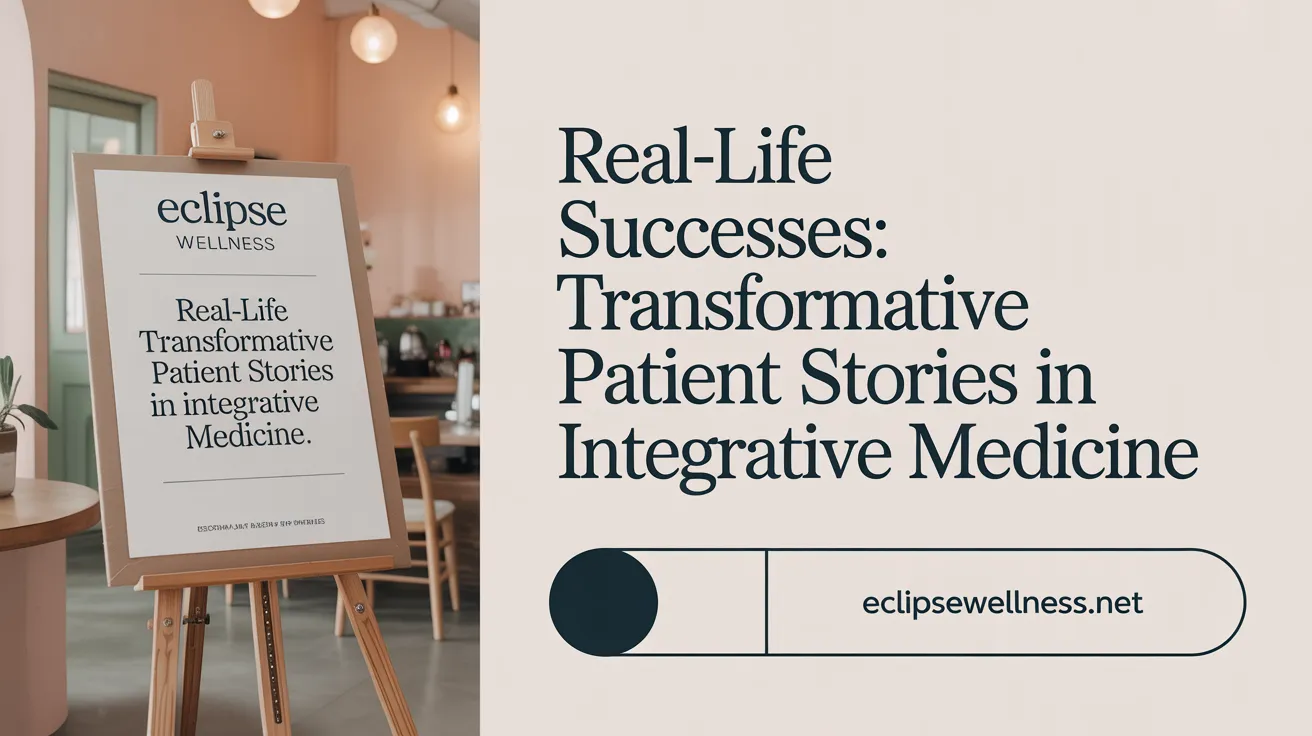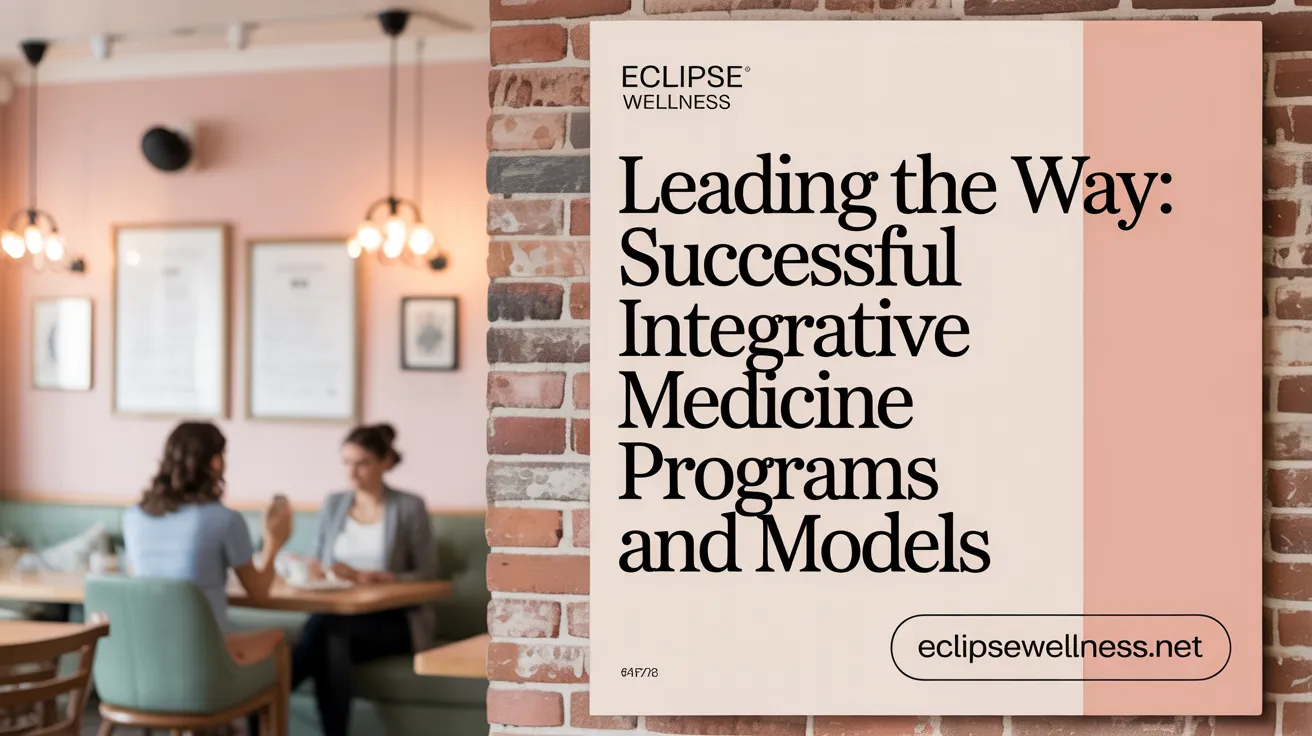A Holistic Revolution in Patient Care
Integrative medicine is reshaping the healthcare landscape by bridging conventional medical treatments with holistic, evidence-based complementary therapies. This evolving approach seeks to treat the whole person—body, mind, and spirit—empowering patients and enhancing their overall experience. By weaving together scientific research and traditional healing practices, integrative medicine offers personalized, comprehensive care that addresses complex health challenges. In this article, we explore patient journeys, scientific foundations, benefits, barriers, and future opportunities in the transformative realm of integrative medicine.
Understanding Integrative Medicine: A Holistic Approach to Healing

What is integrative medicine and how does it enhance patient experiences in healthcare?
Integrative medicine is a comprehensive approach that combines traditional medical treatments with evidence-based complementary therapies. This holistic method focuses on treating the entire person—body, mind, spirit, and environment—rather than just symptoms or diseases.
It incorporates various practices such as acupuncture, nutritional counseling, mind-body techniques like meditation and yoga, herbal medicine, and lifestyle changes, all supported by scientific research. By addressing physical health along with emotional and spiritual well-being, integrative medicine helps manage chronic conditions, reduce symptoms, and promote overall health.
Patients often experience improved satisfaction with their care because treatments are personalized and collaborative. Healthcare providers act as partners, fostering a therapeutic relationship that encourages active participation from individuals in their healing journey. This personalized, respectful approach not only enhances comfort and trust but also leads to better health outcomes.
In addition to symptom relief, integrative medicine emphasizes disease prevention and health maintenance. Its emphasis on natural, minimally invasive therapies aligns with patient preferences for safer, less aggressive options. Overall, this approach aims to create a balanced and supportive healing environment, improving quality of life and empowering patients to take control of their health.
Historical Roots and Core Principles of Integrative Medicine
What are the fundamental principles and historical development of integrative medicine?
Integrative medicine is built on a holistic approach to health care, emphasizing the treatment of the whole person—mind, body, and spirit—rather than just focusing on specific symptoms or diseases. It combines evidence-based conventional medicine with complementary and alternative therapies that have demonstrated safety and effectiveness.
The origins of integrative medicine date back to the early 20th century. During this period, it emerged as a response to the dominance of allopathic, or Western, medicine, which was often criticized for neglecting natural healing and spiritual well-being. Early practitioners, often called 'drugless healers,' included naturopaths, chiropractors, herbalists, shamans, and indigenous healers, each focusing on natural energies and vital forces believed to influence health.
Influenced by these diverse philosophies, the discipline developed further through pioneers like Benedict Lust, who championed naturopathy, and others who emphasized natural healing techniques rooted in traditional wisdom. These foundational ideas stressed the importance of lifestyle, nutrition, and the body's innate capacity to heal itself.
Moving into the modern era, key figures such as Dr. Andrew Weil helped formalize integrative medicine as a scientific, patient-centered discipline. This evolution prioritized evidence-based practices, robust research, and a partnership model between patient and provider. The core principles now include personalized care tailored to individual needs, understanding the significance of lifestyle factors, and employing diverse therapeutic modalities—from acupuncture and yoga to mindfulness and nutrition—to support health.
Today, integrative medicine has matured into an interdisciplinary approach that values cultural sensitivities and continually blends traditional wisdom with cutting-edge scientific research. By fostering a comprehensive view of health, it aims not only to treat illness but also to promote overall well-being and prevention.
Scientific Evidence Validating Integrative Medicine Practices
What scientific evidence supports the use of integrative medicine in improving health outcomes?
Research studies and clinical trials provide substantial support for the safety and effectiveness of many integrative medicine practices. These therapies, which include acupuncture, mindfulness, massage, herbal supplements, and yoga, have been rigorously evaluated through systematic reviews and randomized controlled trials (RCTs). Such research methods help ensure that findings are reliable and based on scientific standards.
The evidence indicates that integrative approaches can achieve meaningful improvements in health metrics. For instance, studies have demonstrated significant pain relief, reduction in stress and anxiety, decreased fatigue, and enhanced quality of life for patients with diverse health conditions such as cancer, fibromyalgia, and chronic pain syndromes.
Institutions like the Mayo Clinic, Memorial Sloan Kettering Cancer Center, and the NIH play crucial roles in advancing this research. They conduct and support investigations into the safety and efficacy of various integrative therapies, emphasizing a rigorous, evidence-based approach.
The inclusion of integrative medicine in clinical guidelines by professional medical organizations further underscores the growing acceptance of its benefits. For example, guidelines recommend acupuncture for managing pain and mindfulness for mental health support, reflecting a shift toward integrating validated complementary practices into mainstream healthcare.
Continuous research efforts are fundamental in evolving the field. Organizations like the NIH have conducted over 6,000 randomized controlled trials on integrative medicine, producing high-quality data that reinforce the clinical relevance of these therapies. Despite some remaining gaps, the expanding body of evidence increasingly supports the role of integrative medicine as an effective, safe, and patient-centered option.
Overall, the scientific insights affirm that when implemented with rigor and appropriate oversight, integrative medicine can complement traditional treatments to improve health outcomes and patient satisfaction.
Benefits and Practical Applications in Patient Care
What are the key benefits and applications of integrative medicine in patient care?
Integrative medicine emphasizes a holistic approach, focusing on treating the whole person—mind, body, and spirit—rather than just symptoms. Patients often experience improved symptom relief, better quality of life, and emotional well-being.
One of the main advantages is its versatility in managing chronic and complex health issues. Conditions such as cancer, autoimmune diseases, chronic pain, and mental health disorders can benefit from complementary therapies integrated with traditional medical treatments. For example, acupuncture, massage, and mind-body techniques like yoga and meditation are commonly used alongside medication or surgical interventions.
Research shows that this approach can lead to better health outcomes, including fewer hospitalizations and reduced healthcare costs. Patients report higher satisfaction levels when treatment plans are personalized and consider their overall lifestyle and emotional needs.
Practically, integrative medicine helps reduce dependency on medications, especially opioids for pain management, by offering alternative options such as acupuncture, herbal medicine, and mindfulness practices. These therapies can alleviate pain, nausea, fatigue, and anxiety, often with minimal side effects.
Examples of integrative therapies include:
- Acupuncture for pain and nausea
- Herbal supplements for immune support
- Yoga and tai chi for stress and mobility
- Mindfulness and meditation for mental health
- Massage therapy to promote relaxation and healing
By combining evidence-based complementary therapies with conventional medicine, integrative medicine serves as a valuable tool in fostering patient-centered care, boosting recovery, and supporting overall wellness.
Patient Stories: Real-Life Triumphs Through Integrative Medicine

How do integrative medicine approaches help patients overcome health challenges through holistic treatments?
Integrative medicine supports patients by combining traditional medical treatments with evidence-based complementary therapies. This includes practices like acupuncture, meditation, nutritional counseling, and herbal remedies. The goal is to address not only physical symptoms but also emotional, mental, spiritual, and social factors that influence health.
Patients often find that this holistic approach fosters a greater sense of wellbeing and resilience. For example, those with chronic conditions such as cancer or diabetes report feeling more in control of their health and experience fewer side effects from treatments. Research shows that integrative practices can reduce mortality risks, alleviate pain, and speed up recovery.
Personalized care is at the heart of integrative medicine. By tailoring treatments to individual needs and preferences, patients are more engaged in their healing journey. This often leads to higher satisfaction and better health outcomes. Whether managing chronic pain, coping with serious illness, or improving mental health, patients benefit from therapies that support the whole person.
Real-life stories highlight these triumphs. One cancer survivor credits yoga, acupuncture, and mindfulness meditation for enhancing her quality of life during treatment. Another patient with chronic fatigue found relief through a combination of nutritional guidance and herbal supplements. These examples underscore the effectiveness of holistic, patient-centered approaches.
In summary, integrative medicine offers a comprehensive pathway to health that respects each person’s unique physical, emotional, and spiritual needs. It empowers patients to take an active role in their healing and promotes overall wellness, making it a valuable component of modern healthcare.
Barriers and Challenges in Integrative Medicine Adoption

What are the main barriers and challenges healthcare practitioners face when integrating complementary and alternative medicine (CAM) into clinical practice?
Integrative medicine aims to combine conventional healthcare with holistic and complementary therapies. However, several hurdles hinder its widespread adoption in clinical settings.
One major obstacle is financial and insurance-related challenges. Many CAM treatments are not covered by insurance plans, making out-of-pocket costs high for patients and limiting access. This financial barrier discourages both providers and patients from pursuing integrative approaches.
In addition, there is a lack of comprehensive clinician education regarding CAM therapies. Many healthcare providers have limited training or familiarity with these modalities, leading to ambiguity and hesitation about recommending or integrating them safely.
Ideological and cultural resistance also play significant roles. Some practitioners and healthcare systems question the safety, scientific validity, or efficacy of CAM. This skepticism is compounded by deeply rooted cultural biases and procedural traditions that favor conventional medicine.
Research and methodological challenges are notable as well. Diverse CAM therapies are often difficult to standardize and study under traditional research protocols. Limited high-quality clinical trials and standardized guidelines hamper the evidence base needed to inform safe and effective practice.
Regulatory and facility issues further complicate integration. Variations in certification standards, lack of clear regulatory frameworks, and inadequate facilities restrict the safe delivery of CAM therapies within mainstream healthcare environments.
Addressing these challenges requires concerted efforts, including developing credible certification standards, expanding research training for clinicians, and fostering dialogue among healthcare disciplines. By overcoming these barriers, integrative medicine can more effectively support holistic patient care.
Healthcare Providers' Perceptions Impacting Integration of Complementary Therapies
How do healthcare practitioners' perceptions and attitudes affect the integration of complementary and alternative medicine into conventional healthcare?
Practitioners' perceptions and attitudes are pivotal in shaping how complementary and alternative medicine (CAM) becomes part of mainstream healthcare. When healthcare providers have a positive outlook and are familiar with CAM practices, they are more inclined to recommend or incorporate these therapies into patient care. For example, many clinicians recognize the benefits of therapies like acupuncture, yoga, and mindfulness in managing symptoms such as pain, fatigue, and stress.
Knowledge and confidence play significant roles. Providers with a good understanding of CAM, supported by evidence demonstrating safety and effectiveness, tend to be more supportive. Conversely, skepticism often arises from concerns about the scientific rigor of some CAM therapies, safety regulation gaps, and potential costs.
Supportive attitudes frequently stem from clinical experience, belief in patient-centered care, and respect for individual autonomy in healing choices. On the other hand, skepticism may be fueled by limited research or institutional barriers.
This spectrum of perceptions can either facilitate or hinder widespread adoption of CAM practices. Many healthcare professionals advocate for better research, formal education, and training to expand their understanding. Such efforts aim to bridge gaps, reduce misconceptions, and foster an environment where CAM can be effectively integrated, ensuring holistic and patient-centered care.
Strategies to enhance the integration involves improving education, establishing clear regulations, and promoting communication among healthcare professionals.
Efforts like certifications, clinical guidelines, and continuing education modules are increasingly being implemented. These initiatives seek to improve practitioners' knowledge base, foster trust, and ultimately, enhance the collaborative efforts needed to offer comprehensive, holistic healthcare services.
Successful Models and Programs in Integrative Medicine

Which established clinical programs demonstrate success in integrative medicine?
Several prominent healthcare institutions have successfully integrated integrative medicine into their clinical practice. Among the most notable is the Mayo Clinic, which offers comprehensive services that include herbs, supplements, meditation, wellness coaching, acupuncture, massage, movement therapies, resiliency training, and nutrition. This program treats thousands of patients annually and emphasizes evidence-based practices tested for safety and effectiveness.
Endeavor Health’s Integrative Medicine Program is recognized as one of the largest and most established in the country. Practitioners use a variety of complementary therapies, working closely with patients’ conventional healthcare providers to create personalized, holistic treatment plans.
How does team-based care enhance integrative medicine?
A common feature of successful programs is team-based care, which focuses on coordinating efforts among different healthcare professionals to address the whole person. Mayo Clinic’s approach emphasizes collaboration among integrative medicine experts, physicians, and specialists to develop tailored treatments aligned with patient needs.
This team approach fosters better communication, comprehensive care, and ensures that therapies are integrated seamlessly with conventional treatments, boosting patient confidence and outcomes.
What are some examples of therapies offered?
Programs typically include a wide range of therapies such as:
- Herbal medicine and supplements: Used to support immune health and symptom management.
- Mindfulness and meditation: Techniques to reduce stress and improve mental clarity.
- Acupuncture and East Asian medicine: Addressing pain, headaches, and digestive issues.
- Massage and manual therapies: Promoting relaxation and physical healing.
- Yoga, Tai Chi, and movement therapies: Enhancing flexibility, balance, and mental health.
- Nutritional counseling: Supporting chronic disease management and overall wellness.
What are the patient outcomes and satisfaction levels?
Research and patient reports consistently indicate that integrative medicine programs improve symptom relief, mental, and emotional well-being. Patients undergoing treatments for conditions like cancer, chronic pain, and fatigue often report increased satisfaction due to the personalized, holistic approach. These programs help reduce reliance on medications like opioids, improve quality of life, and foster a sense of control over health.
Overall, these successful models highlight the importance of evidence-based, multidisciplinary, patient-centered care that combines conventional and complementary therapies to achieve better health outcomes.
| Program Name | Main Focus | Therapies Included | Patient Benefits |
|---|---|---|---|
| Mayo Clinic | Comprehensive, evidence-based integrative care | Herbs, supplements, meditation, acupuncture, massage, nutrition | Improved symptoms, satisfaction, safety |
| Endeavor Health | Large-scale multidisciplinary approach | Acupuncture, manual therapy, wellness coaching, dietary advice | Holistic wellness, symptom management |
This widespread adoption and success of integrative medicine in leading healthcare institutions underscore its role in transforming patient care, emphasizing the importance of a multidisciplinary and holistic approach.
Global Trends and Research Growth in Integrative Medicine
Increase in Scholarly Output
Research on integrative medicine is rapidly expanding, reflecting growing scientific interest and validation of its practices. From 2014 to 2023, scholarly articles on traditional, complementary, and integrative medicine increased from approximately 175,000 to over 248,000 publications. This surge indicates a significant shift towards understanding and integrating these approaches into mainstream healthcare. Many of these studies assess the safety, efficacy, and application of therapies such as acupuncture, herbal medicine, mindfulness, and yoga.
International Usage Statistics
Globally, integrative medicine is widely adopted by populations seeking holistic health solutions. In Europe, an estimated 100 million people use traditional, complementary, and integrative (TCIM) therapies. In the United States, over 37% of adults incorporate some form of TCIM into their health routines, driven by desires for symptom relief, improved quality of life, and a more active role in managing health. These practices are popular among older adults, with a noteworthy number of Americans aged 50 to 80 actively engaged in such therapies.
Standardization Efforts
To enhance credibility and safety, many countries and organizations are working towards establishing standards for integrative practices. International guidelines are being developed to ensure quality and consistency, alongside national certifications for practitioners. For example, the American Board of Physician Specialties offers certification in integrative medicine, which involves rigorous testing and maintains high professional standards. Standards help legitimize therapies, foster trust among patients, and facilitate integration into conventional healthcare systems.
Research Funding and Training
The growing scientific interest is supported by increased funding for research into integrative methods. The NIH alone has conducted over 6,000 randomized controlled trials, providing a solid evidence base that underpins clinical guidelines. Additionally, universities and professional associations are expanding training programs for practitioners, emphasizing evidence-based practice and interdisciplinary collaboration. This focus helps address barriers such as lack of clinician education and ideological differences.
Implementation Science Practices
To effectively incorporate integrative medicine into healthcare systems, the field is adopting implementation science practices. These approaches study how best to integrate evidence-based therapies into real-world settings, overcoming barriers like cultural resistance and infrastructural challenges. Strategies include staged implementation, stakeholder engagement, and policy development. Such practices aim to make integrative therapies more accessible, standardized, and accepted globally.
| Aspect | Details | Supporting Data |
|---|---|---|
| Scholarly Articles | From 175k in 2014 to 248k in 2023 | '^Increase in academic publications^' |
| Population Usage | 100 million in Europe, 37% in US | '^Global and US statistics^' |
| Certification & Standards | Certification by ABPS, international guidelines | '^Efforts for standardization^' |
| Research Funding | 6,000+ NIH trials, expanded funding | '^Research support and validation^' |
| Practice Integration | Adoption of implementation science methods | '^Real-world integration efforts^' |
Future Opportunities and Strategies for Broader Clinical Implementation

What opportunities exist for implementing integrative medicine more broadly in clinical practice?
The future of integrative medicine in clinical settings presents numerous promising opportunities. As patient awareness and demand for holistic, personalized healthcare grow, healthcare systems are increasingly recognizing the value of integrating complementary approaches alongside conventional treatments.
One significant opportunity lies in leveraging expanding scientific evidence. Over 6,000 randomized controlled trials conducted by organizations like the NIH support the safety and effectiveness of many integrative therapies, paving the way for broader acceptance. This growing body of research helps bridge the gap between traditional practices and mainstream medicine, facilitating integration into standard care protocols.
The establishment of international standards and certifications—such as those offered by the American Board of Integrative Medicine—confers professional legitimacy. These certifications help define core competencies for practitioners, promoting trust and professionalism in the field.
Medical education is another vital area for expansion. Incorporating integrative medicine principles into training programs for physicians, nurses, and other healthcare providers can enhance understanding, reduce misconceptions, and foster collaborative delivery of patient-centered care.
Policy reform and insurance modifications also create pathways for broader implementation. When healthcare policies support reimbursement for evidence-based integrative therapies, access increases, enabling patients from diverse backgrounds to benefit from holistic approaches.
Furthermore, the rising acceptance among diverse populations—especially for managing chronic conditions such as pain, diabetes, and mental health issues—opens avenues for community-based implementation. Personalized, systems-based strategies address complex health needs, reducing dependence on medications and invasive procedures.
Finally, fostering collaborative care models that include health professionals from various disciplines—medical doctors, acupuncturists, nutritionists, and mental health practitioners—can enhance treatment efficacy and patient satisfaction. Such multidisciplinary teams ensure that care is comprehensive, culturally sensitive, and aligned with the evolving landscape of healthcare toward more integrative, holistic practices.
A Path Forward: Integrative Medicine Empowering Patients and Providers
Integrative medicine stands at the forefront of transforming healthcare by fostering a holistic, patient-centered paradigm that embraces both conventional and complementary approaches. Through rigorous research, compassionate care, and collaborative practice models, it addresses complex health challenges and elevates patient experiences. Despite existing barriers, the growing acceptance, expanding evidence base, and emerging opportunities position integrative medicine as a vital component of future clinical practice. By continuing to prioritize education, regulatory support, and interdisciplinary dialogue, healthcare systems can fully harness integrative medicine's potential to improve outcomes, reduce costs, and enrich the healing journey for patients worldwide.
References
- Integrative Medicine as a Vital Component of Patient Care
- Integrative Medicine and Health - Overview
- Bridging the Gap: Integrative Medicine in Modern Clinical ...
- Addressing the Challenges of Traditional, Complementary, ...
- Empowering Patients with Integrative Medicine
- What is integrative medicine, and how could it help you?
- Why More Doctors Are Embracing Integrative Medicine
